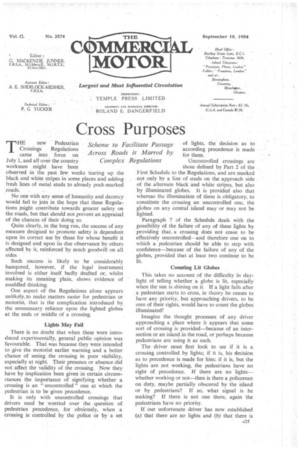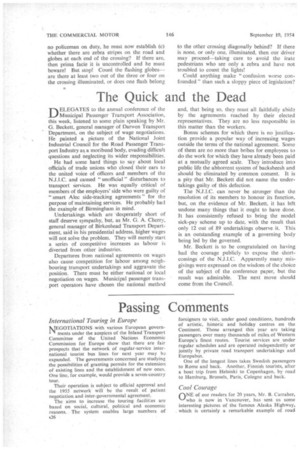Cross Purposes
Page 27

Page 28

If you've noticed an error in this article please click here to report it so we can fix it.
THE new Pedestrian Crossings Regulations came into force on July I, and all over the country workmen might have been observed in the past few weeks tearing up the black and white stripes in some places and adding fresh lines of metal studs to already pock-marked roads. .
No one with any sense of humanity and decency would fail to join in the hope that these Regulations might contribute towards greater safety on the roads, but that should not prevent an appraisal of the chances of their doing so.
Quite clearly, in the long run, the success of any measure designed to promote safety is dependent upon its correct use by those for whose benefit it is designed and upon its due observance by others affected by it, reinforced by much goodwill on all sides Such success is likely to be considerably hampered, however, if the legal instrument involved is either itself badly drafted or, whilst making its meaning plain, shows evidence of muddled thinking.
One aspect of the Regulations alone appears unlikely to make matters easier for pedestrian or motorist, that is the complication introduced by the unnecessary reliance upon the lighted globes at the ends or middle of a crossing.
Lights May Fail There is no doubt that when these were introduced experimentally, general public opinion was favourable. That was because they were intended to give the motorist earlier warning and a better chance of seeing the crossing in poor visibility, especially at night. Their presence or absence did not affect the validity of the crossing. Now they have by implication been given in certain circumstances the importance of signifying whether a crossing is an " uncontrolled " one at which the pedestrian is to be given precedence.
It is only with uncontrolled crossings that drivers need be worried over the question of pedestrian precedence, for obviously, when a crossing is controlled by the police or by a set of lights, the decision as to according precedence is made for them.
Uncontrolled crossings are those defined by Part 2 of the First Schedule to the Regulations, and are marked not only by a line of studs on the approach side of the alternate black and white stripes, but also by illuminated globes. It is provided also that whereas the illumination of these is obligatory, to constitute the crossing an uncontrolled one, the globes on any central island may or may not be lighted.
Paragraph 7 of the Schedule deals with the possibility of the failure of any of these lights by providing that, a crossing does not cease to be effectively uncontrolled—and therefore one on to which a pedestrian should be able to step with confidence—because of the failure of any of the globes, provided that at least two continue to be lit.
Counting Lit Globes This takes no account of the difficulty in daylight of telling whether a globe is lit, especially when the sun is shining on it. If a light fails after a pedestrian starts to cross, in theory he ceases to have any priority, but approaching drivers, to be sure of their rights, would have to count the globes illuminated!
Imagine the thought processes of any driver approaching a place where it appears that some sort of crossing is provided—because of an intersection or an island in the road, or perhaps because pedestrians are using it as such.
The driver must first look to see if it is a crossing controlled by lights; if it is, his decision as to precedence is made for him; if it is, but the lights are not working, the pedestrians have no right of precedence, if there are no lights— whether working or not—then is there a policeman on duty, maybe partially obscured by the island or by pedestrians? If so, what signal is he making? If there is not one there, again the pedestrians have no priority.
If our unfortunate driver has now established (a) that there are no lights and (b) that• there is no policeman on duty, he must now establish (c) whether there are zebra stripes on the road and globes at each end of the crossing? If there are, then prima facie it is uncontrolled and he must beware! But stop! Count the flashing globes— are there at least two out of the three or four on the crossing illuminated, or does one flash belong • to the other crossing diagonally behind? If there is none, or only one, illuminated, then our driver may proceed—taking care to avoid the irate pedestrians who see only a zebra and have not troubled to count the lights!
Could anything make "confusion worse confounded" than such a sloppy piece of legislation?




















































































